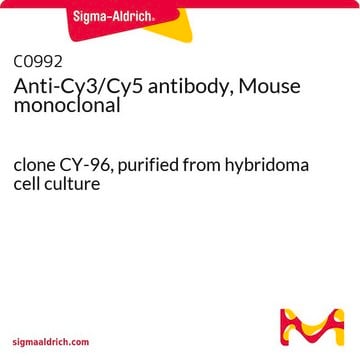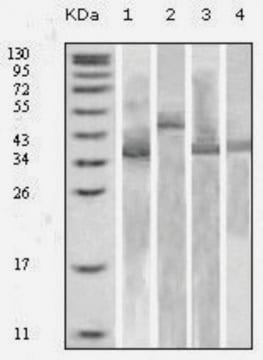C1117
Anti-Cy5 antibody, Mouse monoclonal
clone CY5-15, purified from hybridoma cell culture
Sinônimo(s):
Cy5 Antibody, Cy5 Antibody - Anti-Cy5 antibody, Mouse monoclonal, Monoclonal Anti-Cy5 antibody produced in mouse
About This Item
Produtos recomendados
fonte biológica
mouse
Nível de qualidade
conjugado
unconjugated
forma do anticorpo
purified immunoglobulin
tipo de produto de anticorpo
primary antibodies
clone
CY5-15, monoclonal
forma
buffered aqueous solution
embalagem
antibody small pack of 25 μL
concentração
~1.5 mg/mL
técnica(s)
direct ELISA: suitable
dot blot: 1-2 μg/mL using cell protein extracts labeled with Cy5
immunocytochemistry: suitable
immunoprecipitation (IP): suitable
microarray: suitable
Isotipo
IgG1
Condições de expedição
dry ice
temperatura de armazenamento
−20°C
modificação pós-traducional do alvo
unmodified
Descrição geral
Especificidade
Imunogênio
Aplicação
forma física
Exoneração de responsabilidade
Not finding the right product?
Try our Ferramenta de seleção de produtos.
Código de classe de armazenamento
12 - Non Combustible Liquids
Classe de risco de água (WGK)
WGK 1
Ponto de fulgor (°F)
Not applicable
Ponto de fulgor (°C)
Not applicable
Equipamento de proteção individual
Eyeshields, Gloves, multi-purpose combination respirator cartridge (US)
Certificados de análise (COA)
Busque Certificados de análise (COA) digitando o Número do Lote do produto. Os números de lote e remessa podem ser encontrados no rótulo de um produto após a palavra “Lot” ou “Batch”.
Já possui este produto?
Encontre a documentação dos produtos que você adquiriu recentemente na biblioteca de documentos.
Nossa equipe de cientistas tem experiência em todas as áreas de pesquisa, incluindo Life Sciences, ciência de materiais, síntese química, cromatografia, química analítica e muitas outras.
Entre em contato com a assistência técnica








